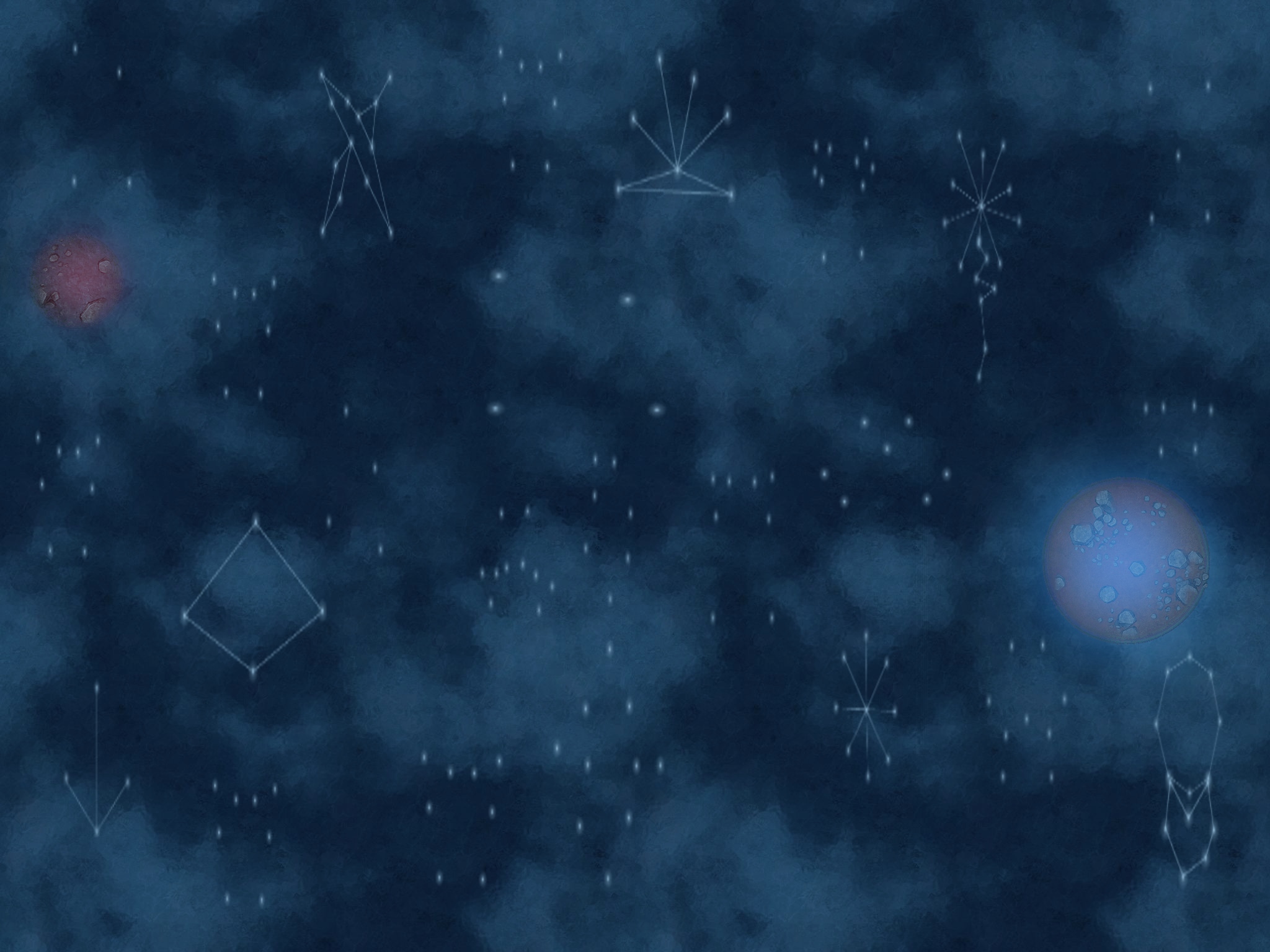The night sky over Caemothas, is a cosmic tapestry filled with mystery and myth. The background is a deep, inky blue, with hints of smoky clouds giving the scene a mystical, dreamlike quality. The sky is dotted with stars of varying brightness, clustered together in both dense patterns and scattered formations, creating a sense of depth and distance.
In the left part of the sky, a reddish moon glows faintly, its surface marred with craters, giving it an ancient, scarred appearance. On the right, a second moon shines with a soft blue hue, its surface also cratered, but with an ethereal glow that stands out against the darker sky.
Among the stars, constellations are delicately traced, their lines connecting specific stars to form symbolic shapes. Each constellation varies in design—some resemble figures with limbs extended, others look like symmetrical geometric shapes. These constellations hint at mythical stories, representing gods, heroes, and symbols revered by the people of Caemothas.
The Warrior
Appearance
This constellation resembles a figure standing tall, with one arm extended as if wielding a sword or spear.
Lore
The Warrior is one of the oldest constellations in Caemothan mythology. Legends say it represents Kelorin, an ancient hero who defended the land against monstrous beasts and dark forces. He is often invoked by soldiers and protectors as a symbol of bravery.
Cultural Significance
Many clans and armies wear the symbol of The Warrior on their armor, believing it grants them the courage and strength to face any challenge. Stories tell that if you see The Warrior constellation clear and bright on the night before a battle, it’s a sign of impending victory.
Seasonal Appearances
The Warrior constellation is most visible during Caemothas’s autumn season, aligning with many harvest festivals where people honor warriors and guardians of their lands.
The Crown
Appearance
Formed by a central point with rays or "spokes" radiating outward, like a circular crown.
Lore
Known as The Crown of Kings, this constellation represents divine authority and wisdom. It is said to be the celestial throne of Altheara, the goddess of leadership and insight. The Crown is often associated with rightful rulers, justice, and the legacy of noble houses.
Cultural Significance
The Crown is considered a powerful omen for those who seek power. Monarchs and rulers look to this constellation for guidance, especially in times of turmoil. It’s believed that when the Crown shines bright, it signifies approval from the gods, often guiding leaders in important decisions.
Seasonal Appearances
The Crown is most prominent in winter, often used as a guiding constellation for travelers during long, dark nights. Its appearance is celebrated in the annual Festival of Light, symbolizing the hope that wisdom will always light the way.
The Archer
Appearance
Slender and elongated, resembling a figure drawing back a bow.
Lore
The Archer represents Viryell, the goddess of the hunt and justice. According to legend, she was a skilled archer who hunted down corrupt beings and brought them to justice. Her constellation is a reminder that no injustice goes unnoticed and that every wrongdoer will be brought to account.
Cultural Significance
Rangers, hunters, and scouts often make offerings to the Archer before embarking on difficult journeys or hunts. This constellation is also invoked during legal proceedings, with people asking for fair outcomes in the eyes of Viryell.
Seasonal Appearances
The Archer is visible year-round but reaches its highest point in the summer, during Caemothas’s hunting season. The constellation is celebrated with archery contests and hunts, symbolizing Viryell’s vigilant watch over the land.
The Diamond
Appearance
This constellation has a clear diamond shape, formed by four prominent stars.
Lore
Known as The Gem of Fortune, the Diamond is believed to be a divine jewel that fell from the heavens. Legends say it was a gift from Tressalia, the goddess of luck and prosperity, to a wandering merchant who shared his fortune with the poor.
Cultural Significance
Merchants, adventurers, and those embarking on new ventures often look to The Diamond for a blessing of good fortune. It’s a favorite symbol in trade guilds, and many carry talismans with its shape. Some believe spotting the Diamond at dawn brings exceptional luck.
Seasonal Appearances
The Diamond shines brightest during the spring equinox, aligning with the annual Festival of Plenty, where communities gather to celebrate and trade.
The Phoenix
Appearance
Shaped with a starburst-like form, resembling wings or flames rising.
Lore
The Phoenix constellation tells the tale of Irixos, a mythical bird that rose from the ashes of
despair to bring hope and renewal to the world. It represents the cycle of death and rebirth, growth, and transformation.
Cultural Significance
The Phoenix is revered by those seeking a fresh start or healing. It’s a powerful symbol among those who have faced hardship, symbolizing the resilience to rise again. Many temples and shrines dedicated to recovery and renewal are marked by its emblem.
Seasonal Appearances
The Phoenix becomes prominent in autumn, symbolizing the end of one cycle and the beginning of another. Its peak is marked by a festival of bonfires, celebrating life’s regenerative power.
The Harp
Appearance
This constellation has a triangular frame, like a small harp or lyre.
Lore
Known as The Harp of Harmony, it is believed to represent the musical instrument of Solanne, the goddess of harmony and peace. Solanne played this harp to calm the first storms and bring peace to warring tribes.
Cultural Significance
Artists, poets, and lovers often make wishes upon The Harp, asking for unity and harmony in their lives. The constellation is also a guide for peacekeepers and diplomats, symbolizing the possibility of resolving conflicts through understanding.
Seasonal Appearances
The Harp is best seen in the early winter nights and is celebrated with gatherings of music, dance, and storytelling. The constellation aligns with the Harmony Festival, a time of peace where even longstanding feuds are put to rest.



Comments